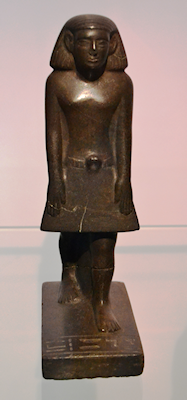
Cite this as: Zuanni, C. 2017 Unintended Collaborations: interpreting archaeology on social media, Internet Archaeology 46. https://doi.org/10.11141/ia.46.2
Perry and Beale (2015) commented that archaeologists have enthusiastically used digital media to disseminate their research and develop different projects with a view not only to communicate the past, but also at involving the public in the process; however, they argued, there has been a lack of critical reflection on these practices. Little research has been carried out on the use and impact of digital media in communicating archaeology (Bonacchi 2012a; Richardson 2013; Walker 2014), even though, as Isto Huvila argues, 'the use of social media can affect not only popular ideas of archaeology and the contexts of its relevance, but also archaeological knowledge (i.e. what is known and what is desirable to be known)' (Huvila 2013, 21).
The lack of critical evaluation of archaeologists' practices and initiatives on social media has been paralleled by a limited understanding of the different ways audiences interact with archaeology on digital media. Discussing earlier examples of web platforms (the Çatalhöyük and the Jordan Plantation websites), McDavid (2004) highlighted the limits of online participation and multivocality, and, more recently, she added that self-selected social networks prevent 'users' exposure to alternate views' (McDavid and Brock 2015, 173). A few recent PhD theses have also begun to unpack different aspects of the impact of digital media on heritage audiences (Bonacchi 2012b; Richardson 2014; Walker 2016; Zuanni 2016), but there is still a lack of understanding of the motivations for digitally enabled engagement with the discipline and the different fora where archaeology is discussed beyond professional initiatives (as argued also by Maldonado 2016).
So far, authors have emphasised the impact of popular culture on public perceptions of archaeology (e.g. Holtorf 2005; 2007), and have analysed representations of the past via a range of media, such as museums (Moser 2003; 2006; 2010), television and magazines (Smiles and Moser 2005; Nichols 2006; Kulik 2007; Clack and Brittain 2007; Bonacchi 2013), newspapers (Finn 2001), literature (Evans 1993), science fiction (Russell 2002), and videogames (e.g. Reinhard nd; García-Raso 2011; Copplestone 2016; 2017; Mol et al. 2017). Stephanie Moser highlighted how 'computer games enabled people to participate in the past in a way that other kinds of archaeological engagement had not previously offered' (Moser 2009, 1071) and the importance of these games in drawing attention to the discipline is demonstrated, for example, by the fact that since 2010, one of the main drivers of Google searches for the word 'archaeology' has been the game World of Warcraft, which in that year added the character of an archaeologist to its Cataclysm expansion (Google Trends, Last accessed: 25 July 2016). This article aims thus to contribute to the study of archaeological representations on social media and it discusses how social media content could be explored in order to gain a better understanding of public perceptions of archaeology.
For this reason, the research presented in this article aims also to feed into existing literature and research on the public understanding of the discipline of archaeology. Since the 1980s, there have been a few studies on archaeology audiences conducted using different methods: in the UK, data have been jointly collected and analysed by Ian Hodder, Mike Parker-Pearson, and Peter Stone in 1983-1984 (as discussed in Hodder 1984; Stone 1994); Merriman in 1985 (Merriman 1991); and through an IPSOS MORI survey commissioned by English Heritage in 2000 (Cossons 2000; MORI 2000). At the same time, similar studies have been carried out in North America (Feder 1984; 2006; Mackinney 1994a; 1994b; Pokotylo and Mason 1991; Pokotylo and Guppy 1999; Pokotylo 2002), and in 2000 the Society for American Archaeology commissioned a survey on perceptions and attitudes towards archaeology from an external specialist society (Ramos and Duganne 2000). Between December 2014 and January 2015, the European project NEARCH has conducted a new survey, interviewing online 4156 adults and assessing the perceptions and values of heritage across nine European countries (Kajda et al. 2017). Other studies have focused on the reception of particular media e.g. television (e.g. Piccini and Henson 2006; Schall 2010), or a more circumscribed geographical area (e.g. Almansa 2006; Bohne and Heinrich 2000).
In these surveys, the 'Internet' as a source of archaeological knowledge was first cited in a 1999 survey of Vancouver's residents (Pokotylo and Guppy 1999), and its growth is emphasised in more recent years by a French survey by INRAP (Institut national de recherches archéologiques préventives), who commissioned IPSOS to carry out a preliminary study in 2006, followed by a broader survey in 2010 (De Sars and Cambe 2010). Both sets of surveys included the use of the internet as a source of archaeological information, an option that was selected by 14% of the interviewees in 2006 against 41% of interviewees in 2010 (whereas traditional media such as television and press both decreased).
Since these surveys, social media have also become an important channel through which audiences get to know about archaeology, whether as part of a professionally led initiative or as casual encounters with online content relating to it (from memes to news articles, from social media streams to websites presenting alternative accounts of the past). The importance of digital media is now strongly advocated in the field, but more research is needed about our audiences, on the reach and impact of digital public archaeologies, and on the way archaeology is presented and discussed online. On the one hand, there are not yet clear frameworks and shared methodologies for in-depth evaluations of the reach of digital projects, and on the other social media data offer new opportunities to observe how users engage with archaeology in their everyday lives, beyond professional initiatives.
In June 2013, a video of an Egyptian statuette apparently moving of its own accord in its case in the Manchester Museum's Ancient Worlds Galleries went viral (Lovelock 2013; Figure 1).

The curator had already noted in his blog earlier that same year (Price 2013c) that this serpentine statuette had been found slightly rotated in its case, and he had also announced that the museum intended to set up a camera to record the rotation (Price 2013a). The resulting video, a time-lapse, was published on YouTube and on the Egypt at Manchester blog (Price 2013b), and, crucially, in the Manchester Evening News on Saturday 22 June (both in print and online; Keegan 2013). The blog post suggested that vibrations were the cause of this rotation, but this did not stop the video quickly catching the attention of the press and the imagination of online users. In a couple of hours, the video was already being published in international news outlets (to my knowledge, the first non-UK media to report it was a Serbian newspaper, InSerbia 2013) and over the weekend news outlets all over the world reported it, and journalists contacted the museum staff for interviews (as of summer 2016, the video has had almost 5 million views). In the following week, media articles started to discuss the episode, noticing how this huge attention had brought record visitor numbers to the museum (e.g. Wheatstone 2013). Finally, in the autumn, there was a second wave of media interest, owing to an episode of the ITV series Mystery Map (ITV 2013), which investigated this case and concluded that the vibrations caused by the traffic on the nearby Oxford Road had caused the rotation.
As part of my PhD research, investigating the impact of public perceptions of archaeology on museums, I was already drawing on the Manchester Museum as a case study. I was therefore well placed to start collecting data on the episode, and my final dataset included 534 news websites, blogs, and forums, 70 YouTube videos with comments, 14,927 tweets, and 87 traditional media (local and national newspapers, TV, and radio). Furthermore, I analysed 3000 comments coming from a selection of 51 online news articles. I also spent some time in the galleries observing visitors' interaction with the statuette. To my knowledge, this is the first investigation of 'viral' archaeological news (Figure 2 shows its global reach) and it also differs from previous research on online reporting of archaeological news due to the wide range of sources analysed.
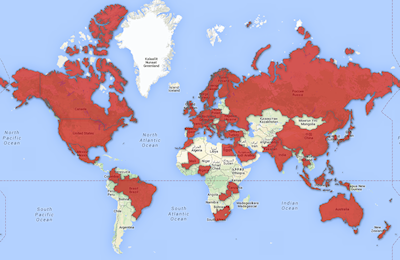
In this sense, it differs also from previous online ethnographies, which focused on a single platform (e.g. a forum, blogging, Twitter, etc.) in order to analyse in depth a community online practice (e.g. professional archaeologists; participants in a public archaeology project; gamers; etc.). This research has instead aimed to cut across different platforms and audiences, in order to explore how a single news item, the spinning statuette, was reframed and commented upon by a variety of users in different forms. I am therefore following Kozinets's suggestion that in a netnographic investigation it is important 'to experience online social interaction in the way that your participants are experiencing it. This often means following many different types, forms, and structures of online communication' (Kozinets 2010, 87).
Viral news has been researched in marketing, journalism, political sciences, social sciences, and media studies (Lievrouw and Livingstone 2006; Messaris and Humphreys 2006; Graeff et al. 2014; Rudat et al. 2014; Rudat and Buder 2015) and there is not yet a comprehensive tool to capture impact and spread. Thus, each platform has been investigated separately, considering its terms and conditions, the available tools for data-mining and the possibility of interacting directly with the platform's API (application programming interface).
Tweets were collected with TAGS, a free Google Sheet template that allows the collection of tweets for a hashtag or a keyword (tags.hawksey.info, last accessed: 25 July 2016). The Twitter API limits the collection to a maximum of 1500 tweets per search or to tweets posted during the last seven days: to avoid this limit I set up an hourly search for the hashtag '#spinningstatue' and a second one for the phrase 'Manchester Museum' within two hours of the publication of the video. However, while the almost 15k tweets analysed are evidence of the global reach of this story, there are two main limitations to this dataset: firstly, there was not a unique hashtag used to share this news and, secondly, the hashtag and keywords I tracked were in English. Therefore, in line with other studies on viral Twitter news, these Twitter data should be considered 'as a reasonably representative sample rather than a comprehensive dataset' (Bruns and Burgess 2012, 805).
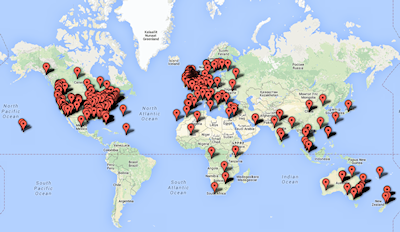
Furthermore, the misalignment between Twitter users and the general population (Bruns and Burgess 2012) is exemplified by a Daily Mail article. The article was tweeted only 91 times, but it gained by far the most comments on the tabloid website (1280 comments). Interestingly, both comments and tweets demonstrate the global reach of this article, which was both shared and commented on by users across the world (Figures 3-4). Conversely, the BBC and the CNN online articles, on which it was not possible to comment directly, were shared more than 1000 times on Twitter, as was an article from the Independent (which received only three comments). These data highlight the importance of including in the analysis data from different platforms, in order to gather perceptions and opinions on the event from a wider population.

The collection of online articles, comments below these articles (when available), blogs and forum posts was carried out by adopting a mixed methods approach, which included Google searches (set to avoid personalised results), Bing searches, and a compilation of all the links shared on Twitter. Overall, the online articles come from 28 different countries, with the UK contributing 108 articles (out of 534), followed by the US, Australia, and Indonesia; similar global participation in the discussions is also confirmed by the comments below these online media, blogs and forum threads.
Current ethical guidelines are still unclear with regard to the use of online user-generated content: on one side, there is an emphasis on the attribution of this content (i.e. respecting its copyright); on the other side, social science research usually suggests the anonymity of research subjects. Markham and Buchanan (2012, 4) point out that since 'all digital information at some point involves individual persons, consideration of principles related to research on human subjects may be necessary even if it is not immediately apparent how and where persons are involved in the research data'. Thus, though the content I was dealing with did not appear immediately sensitive, I anonymised all the data. Additionally, Hardey (2011, 118) argues that quotes from online sources are easily retrievable, through Google searches, and therefore I took particular attention when quoting user texts, and in selected cases I chose, as suggested by Hardey, to change the text slightly (e.g. changes to the order of words/subordinate clauses; use of ellipsis), in order to protect the anonymity of a research subject.
The contribution of social media data to the understanding of archaeology audiences is twofold: on one side, analytics reveal how archaeology is mediated in the digital sphere and how different publics encounter it; on the other side, this user-generated data contributes to the understanding of representations and public perceptions of the past.

Both media articles and social media reactions peak in the few days immediately following the publication of the video: for example, most of the tweets were shared over only four days, between 23 and 26 June, with a maximum of 5500 Tweets on 25 June 2013 (Figure 5). Twitter data, particularly, are interesting because they show how users circulated the news. An examination of the source of the tweet (Figure 6) shows how most of the users were simply sharing a news item found elsewhere (e.g. an online article) through a Twitter button on the webpage, and indeed content analysis of the tweets shows that around 50% of the tweets contained only the news headline and link, without any further comment.
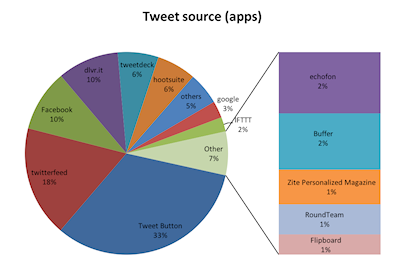
Another segment of the tweets was shared from bookmarking websites, suggesting that these users had chosen to follow archaeology-related news: however, it should be considered that since the video became viral, it appeared also in other sections of news sites (i.e. users who did not indicate an interest in archaeology might also have encountered it). Tweet management apps, such as Hootsuite, were also present and the use of these apps, alongside Twitter itself (which is demonstrated by the high number of retweets without any modification), raise the question of users' engagement with the news: did all the people who shared a tweet actually read the news? The analysis of tweets that contained some added content to the simple news headline shows that a few users were simply tweeting links to the video while tagging friends so as to signal the episode, while the majority of users who added some comment limited themselves to short generic words denoting fascination or fun (e.g. 'wow', 'creepy', etc.).
Viral YouTube videos have been categorised in two main types by Jean Burgess, who suggests that a first type 'become[s] extremely popular as one-offs, via word-of-mouth combined with media hype' (Burgess 2008, 102), while a second type of viral videos 'attract[s] active, participatory and creative engagement from other participants' (Burgess 2008, 103). Most of the YouTube videos relating to the spinning statuette belonged to the first type, re-posting the original video without any added comment. There were only a few exceptions in which users appropriated the video, adding a different layer to its significance, and could thus be related to the second type of video identified by Burgess. Among these, the most interesting case was that in which — drawing on Illuminati's symbolism, conspiracy theories against Barack Obama, and Biblical quotations — the rotation of the spinning statuette was interpreted as proof of the imminent end of the world and of the second coming of Jesus Christ (TheGroxt1 2013).
Briefly, a closer look at the analytics demonstrates how the news spread and how the public learnt about it. This process was beyond the museum's control: once the news was published online, users' networks — based on friendships or different shared interests (for example, football) shared it independently, and with different degrees of engagement (from heated forum discussions to quick retweets). At the same time, the circulation of the spinning statuette story across different platforms also allowed the collection of an exceptional quantity of data revealing how the story was interpreted by users within different frameworks, drawing on their perceptions of Ancient Egypt and of museums.
News websites did repeatedly — through with different tones and to a different extent — frame the news within the themes of mystery and curses that popular culture has long associated with ancient Egypt. Online comments by users of different platforms were categorised across three main areas: popular images of ancient Egypt; attempts to explain the phenomenon; criticism of the museum. The arguments, motivations, and attitudes of these users add further data and perspectives on public perceptions of the past and of museums.
Examples of popular images and popular culture representations of ancient Egypt ranged from ideas on the mummy's curse to references to blockbuster movies (e.g. Indiana Jones, The Mummy, Night at the Museum, Harry Potter, etc.), TV programmes (e.g. Dr Who's weeping angels), songs ('Walk like an Egyptian'), and comics ('Tintin'). These citations were not being used as interpretative frameworks but served instead as ways of engaging and jokingly commenting on the episode.
Attempts to explain the phenomenon included both sceptic positions (e.g. explaining the movement through rotations, the shape and qualities of the statuette's material) and beliefs in alternative theories (e.g. the presence of aliens in ancient Egypt, belief in a 'curse', different religious frameworks, including Islam, Christianity, Hinduism). For example, Isaiah 19.1 ('The Lord is coming to Egypt, riding swiftly on a cloud. The Egyptian idols tremble before him, and the people of Egypt lose their courage') was one of the most frequent biblical citations used to explain the movement of the Egyptian statuette and this quote was present across platforms (I found it on YouTube, on blogs, and in the comment sections of media websites). Perhaps drawing on an analogy between ancient and contemporary religious practices and beliefs, the spinning statuette contributed to the debate on the existence of the supernatural (i.e. curses and paranormal events), and, ultimately, of the divine (i.e. discussions on miracles, faith, and apocalyptic theories). As noted above, one of the most commented of YouTube's videos also drew on a religious explanation, in line with Thelwall's finding that videos featuring religion are those attracting more engagement on YouTube (Thelwall et al. 2012).
As a consequence of these debates, some users criticised the Manchester Museum for what was perceived as a marketing stunt, and a comment left below an online article goes beyond this by suggesting that the video 'would be a great hoax to get more visitors who believe in this nonsense'. Indeed, other users criticised the fact that the museum had allowed the emergence of alternative views on the past, fostering (in their view) 'non-scientific' beliefs. These comments highlighted, for example, that 'A museum is a place for scientific study not hocus pocus!' and that 'Museums are places for science and learning, not superstition and hype'. On the other hand, supporters of paranormal explanations would have preferred the museum to engage further with their beliefs, and were therefore criticising it for not accepting alternative beliefs. For example, someone suggested that 'it might be lateral thinking to bring in a psychic or clairvoyant, someone with the genuine gift of being in contact with the spiritual world (…) Science does not always have all the answers!', and another user argued that 'A team of investigators should be well balanced between scientists and paranormal investigators (who frequently employ science in their own investigations, but with a truly open mind)'. This debate also offered, therefore, an insight into public perceptions of museums: both sides appeared to consider the museum as an authoritative institution for the promotion of knowledge. However, what divided the two fields were the limits and boundaries of the knowledge proposed in the museum: too narrow-minded for the supporters of a supernatural theory and too open to alternative accounts for the others.
Finally, the comments on the spinning statuette video also contribute to understanding public perceptions of two relevant themes in current museum practices: restitution and human remains. Some users noted that the statuette should not have been in Manchester in the first place and they argued in favour of its restitution to Egypt. Additionally, other users — drawing also on some incorrect or unclear media articles — confused the statuette with a mummy: this misunderstanding simultaneously reinforced the idea of a curse and prompted them to ask for the removal of this 'mummy' from the display (Zuanni and Price forthcoming).
The spinning statuette case-study demonstrates also the broad range of fora and the different communities across which archaeological news is discussed online. In this sense, the dialogues and networks emerging from this specific episode show that there is a space for a 'democratisation' of archaeology online: in engaging with this episode, users entered into conversations about the interpretation of the phenomenon (Figure 7), and shared their ideas on the role of the museum in disseminating this story. Although staff of the museum discussed the phenomenon and public reaction in the media, the museum could only partially follow up users' posts to engage across different platforms with online audiences.
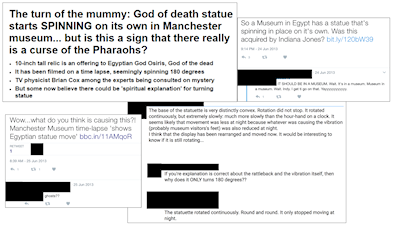
Instead, I argue that it is necessary to develop strategies for engaging with these extensive social media responses on one side, and for analysing them on the other, in order to fruitfully harness public perceptions of the past and build on them to develop new relationships with museums and heritage professionals. Digital media offer the possibility of developing what Sennett has called 'dialogic conversations', in which 'no shared agreements may be reached, [but] through the process of exchange people may become more aware of their own views and expand their understanding of one another' (Sennett 2012, 19). Listening carefully and developing empathy with the interlocutor, however, requires time and — when in the digital sphere — it also depends on the digital skills and tools available. Additionally, in order to develop a truly inclusive dialogue with online audiences, heritage professionals also need to redefine the role of expertise and authority in the digital sphere.
Communications could be enhanced by a more in-depth understanding of online audiences and of the ways expertise is performed and interpreted on social media sites. Expertise in one's own field of study (i.e. archaeology, Egyptology) needs therefore to be complemented by an understanding of social media communication and by an awareness of the different platforms and the diverse nature of online audiences. At the same time, a better awareness of the potential, pitfalls, and impact of such data is also necessary, in order to both improve engagement practices and prepare heritage professionals to deal with online criticism and, at worse, harassment. Other future challenges are represented by the development of skills aimed at the collection of digital data, their management, and the definition of shared practices in regard to the ethics and policies of using user-generated data.
In conclusion, the viral video of the spinning statuette has allowed a methodology to be proposed for the analysis of such data, though future research is needed to adapt this approach to large-scale studies on the public understanding of archaeology and to develop clear and streamlined processes for similar evaluations of smaller case studies. The example of the spinning statuette is admittedly quite exceptional, but I believe that the approach presented here could be both scaled down, to analyse public reactions to archaeological news circulated less widely, and up, to develop broader studies on the public understanding of the past.
Internet Archaeology is an open access journal based in the Department of Archaeology, University of York. Except where otherwise noted, content from this work may be used under the terms of the Creative Commons Attribution 3.0 (CC BY) Unported licence, which permits unrestricted use, distribution, and reproduction in any medium, provided that attribution to the author(s), the title of the work, the Internet Archaeology journal and the relevant URL/DOI are given.
Terms and Conditions | Legal Statements | Privacy Policy | Cookies Policy | Citing Internet Archaeology
Internet Archaeology content is preserved for the long term with the Archaeology Data Service. Help sustain and support open access publication by donating to our Open Access Archaeology Fund.